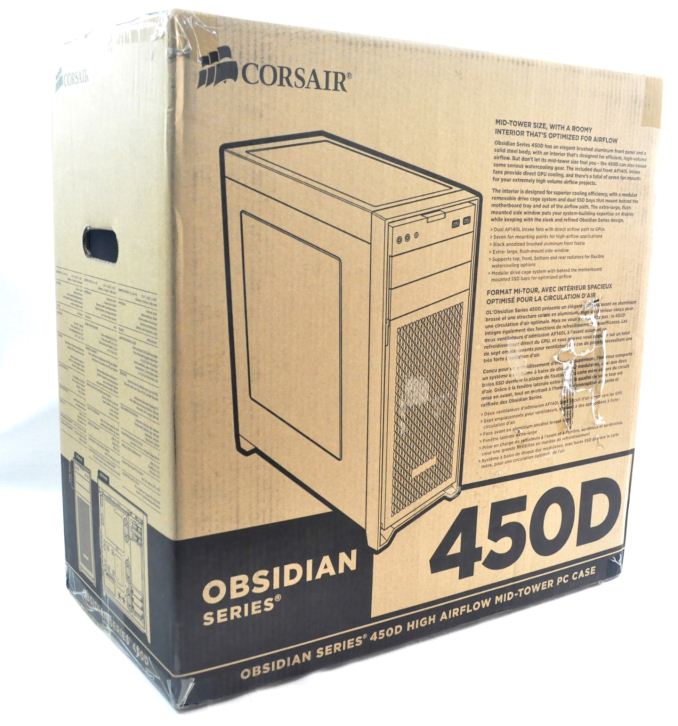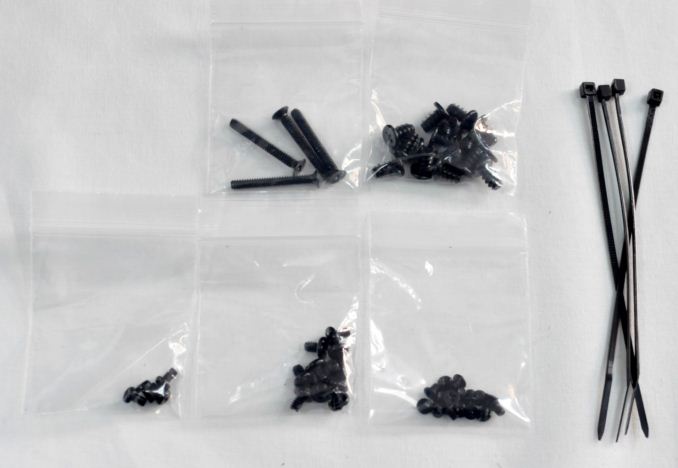Corsair Obsidian 450D Case Review
by E. Fylladitakis on April 4, 2014 6:00 AM EST- Posted in
- Cases/Cooling/PSUs
- Corsair
- mid-tower
- Case

Corsair Obsidian 450D: Introduction and Packaging
Corsair is a company that hardly requires an introduction; almost every PC user has heard of their name and a large number own at least one of their products. More advanced users know that Corsair is one of the oldest companies that's still around. The company was established in 1994 as a cache module manufacturer but their focus changed to DRAM modules a few years later. Corsair began a very aggressive diversification scheme over the past decade, which turned the DRAM manufacturer into a giant that markets several dozen technology-related products, their four series of cases being among the most popular of them.
Depite having over a dozen designs available, Corsair is continuously releasing new cases to enrich their product ranks. It's only been a few months since the release of the Obsidian 250D, a cubic Mini-ITX case, and today yet another product joins the ranks of the Obsidian series. In this review, we'll look at Corsair's newest mid-tower case, the Obsidian 450D, a case designed to bridge the gap between the Micro-ATX Obsidian 350D and the towering Obsidian 750D.
| Corsair Obsidian 450D Specifications | ||
| Motherboard Form Factor | ATX, Micro-ATX, Mini-ITX | |
| Drive Bays | External | 2 x 5.25" |
| Internal |
3 x 2.5"/3.5" (front drive cage) 3 x 2.5"/3.5" (optional front drive cage) 2 x 2.5" (rear of motherboard tray) |
|
| Cooling | Front | 2 x 120 / 140mm (2 x 140mm included) |
| Rear | 1 x 120mm (included) | |
| Top | 3 x 120mm or 2 x 140mm (optional) | |
| Left Side | - | |
| Bottom | optional 2 x 120 (drive cage has to be removed or relocated) | |
| Radiator Support | Front | Up to 240mm / 280mm |
| Rear | 120mm | |
| Top | Up to 360mm / 280mm | |
| Side | - | |
| Bottom | 240mm | |
| I/O Port | 2x USB 3.0, 1x Headphone, 1x Mic | |
| Power Supply Size | ATX | |
| Clearances | HSF | 165mm |
| PSU | Any | |
| GPU | 430mm | |
| Dimensions |
494mm × 210mm × 497mm (H×W×D) 19.5 in × 8.3 in × 19.6 in (H×W×D) |
|
| Prominent Features |
Tool-free 2.5” drive sleds behind motherboard tray 360mm radiator support with removable magnetic filter Removable 3.5” drive cage allows use of 240mm bottom radiator Up to 280mm radiator support in front. |
|
| Price | $119 USD (MSRP) | |
The Obsidian 450D comes in a rather simple, brown cardboard box. The artwork is limited to a basic schematic of the case itself. Inside the box is the case protected by Styrofoam slabs and wrapped in a nylon bag, which should offer ample shipping protection for a typical ATX case.
Alongside with the Obsidian 450D, Corsair supplies only the bare essentials. We only found a handful of black screws and a few cable ties supplied with our sample, as well as a basic installation guide. Considering the class of the Obsidian series, the bundle leaves a lot to be desired -- nicer velcro wraps would be appreciated as an example.












36 Comments
View All Comments
lmcd - Friday, April 4, 2014 - link
I think a reference article suggesting one generic system the test loads would be equal could help?It's tough to envision where these thermal dissipations fall in with the market.
vgray35@hotmail.com - Saturday, April 5, 2014 - link
I do not concur with your reasoning in large part. Yes comparisons are excruciatingly difficult, and in many instances possibly even impossible to construe reasonable conclusions. So what! Comparisons are not everything. Comparisons are difficult yes, but nevertheless a figure of merit in the form of a specific test case gives an idea of what the Case design is capable of achieving, quite apart from the rudimentary machinations of comparing results. We have a need for comparisons to some extent n you constant heat load idea will help here, but we also have a need for a SPECIFIC perspective on Case design. Specific test results are not invalid just because comparisons are difficult. Once I have chosen a specific Computer Case for a build, I use the specific test case as a representative example of internal case design, in terms of airflow and specific components. I am then no longer interested in comparisons.Difficulty in comparing results in no wise invalidates the usefulness of a specific test case, somehow making it useless. Measuring total heat load for a specific test case with CPU etc, temperature rises, is just that - a specific test case - that is not invalidated by some different testing methodology. It remains a real world test - just a SPECIFIC case test, comparisons aside. A single snapshot view and heat load example is not useless expressed in the form of specific components and temperature differentials.
Applying a constant heat load is a good idea as an alternative test, but you reach too far when you declare specific test cases are invalid, just because comparisons of specific test cases are difficult.They provide a figure of merit of one sort, and these are not necessarily intended to be compared with other results. Difficulty in comparisons is not a legitimate reason for abandoning specific test cases, as comparisons are not the holy grail of these results.
I like the notion that: "these specific components loaded to this specific heat load produces a specific series of temperature differentials with this specific Case and components". For example I may want to build the specific test case with only minor changes, and the impact of making the minor changes is what is of interest - not comparisons with other specific tests.
The whole gamut of your methodology intimates that "comparisons are impossible to make", and therefore specific test cases are invalid. That is wrong. Yes settings change things a lot - so just measure input power and temperatures and be done with it. Specific test cases serve much more beyond merely being used for comparison purposes, which makes them valid real world test cases.
vgray35@hotmail.com - Saturday, April 5, 2014 - link
Guess what! real work includes interacting with your client base. Reading review comments constitutes a part of your real word job.FriendlyUser - Friday, April 4, 2014 - link
Great review! I'd really like to see a similar review of the 750D one day, since I'm interested in more spacious enclosures.HisDivineOrder - Friday, April 4, 2014 - link
I wish Corsair would iterate on the 550D with a cube-shape. That'd be hot as an Obsidian product. The current Corsair cube leaves much to be desired.rpjkw11 - Friday, April 4, 2014 - link
I really like Corsair's use of magnetic dust filters, but not on the bottom as in this case. Tipping a case to remove a dust filter for cleaning is, according to Murphy's Law, an accident waiting to happen. That's nitpicking, true, but one little Ooops can ruin one's day, so for me at least, it's a deal breaker. Except for that, the 450D is a great looking, very well designed case.kmmatney - Friday, April 4, 2014 - link
You don't have to tip the case to get the bottom filter - you can use a screw driver to pop it off, or even just your fingers. Well worth it for a dust-free case.FoRealz - Friday, April 4, 2014 - link
Can you please list the weight of the cases? Many thanks!E.Fyll - Friday, April 4, 2014 - link
Yes, I will in future reviews, I just received a proper scale that was bought for that specific purpose.Subyman - Friday, April 4, 2014 - link
It seems Corsair keeps stepping down the quality of plastics they use. The front facia looks like really cheap plastic compared to their older products. This doesn't seem like a $100+ case.